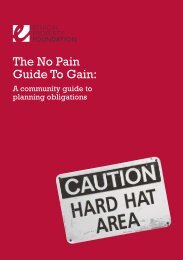Download the TCPA policy statement on Residential Densities
Download the TCPA policy statement on Residential Densities
Download the TCPA policy statement on Residential Densities
You also want an ePaper? Increase the reach of your titles
YUMPU automatically turns print PDFs into web optimized ePapers that Google loves.
<strong>Residential</strong> <strong>Densities</strong><str<strong>on</strong>g>TCPA</str<strong>on</strong>g> POLICY STATEMENTThis <str<strong>on</strong>g>policy</str<strong>on</strong>g> paper is not intended to add to <str<strong>on</strong>g>the</str<strong>on</strong>g> l<strong>on</strong>g list of academic and technical studies ofresidential densities, although it draws particularly <strong>on</strong> recent work by <str<strong>on</strong>g>the</str<strong>on</strong>g> late Professor MichaelBreheny of Reading University, <str<strong>on</strong>g>TCPA</str<strong>on</strong>g> Vice-Chairman, and <strong>on</strong> <str<strong>on</strong>g>the</str<strong>on</strong>g> deliberati<strong>on</strong>s of <str<strong>on</strong>g>the</str<strong>on</strong>g> Associati<strong>on</strong>’sHousing and New Communities Task Team of which he was a member.1 Introducti<strong>on</strong>1.1 For over 100 years <str<strong>on</strong>g>the</str<strong>on</strong>g> <str<strong>on</strong>g>TCPA</str<strong>on</strong>g> has campaigned for housing for all that meets human needs andaspirati<strong>on</strong>s. That categorically does not mean, however, that it promotes very low-densityhousing or that it has ever d<strong>on</strong>e so. From <str<strong>on</strong>g>the</str<strong>on</strong>g> early garden cities to <str<strong>on</strong>g>the</str<strong>on</strong>g> post-Sec<strong>on</strong>d WorldWar new towns, <str<strong>on</strong>g>the</str<strong>on</strong>g> <str<strong>on</strong>g>TCPA</str<strong>on</strong>g>’s c<strong>on</strong>sistent ideal has been medium-density housing in plannedsettlements with a sense of community and good access to jobs, shops, schools, services,and transport. It has c<strong>on</strong>stantly resisted sprawling, unplanned, low-density 20th-centurysuburban development. It c<strong>on</strong>trasts this with <str<strong>on</strong>g>the</str<strong>on</strong>g> more compact suburbs of earlier centuries,to which we need now to return.2 Why does density matter?2.1 Five basic reas<strong>on</strong>s have been cited over <str<strong>on</strong>g>the</str<strong>on</strong>g> 60 years since <str<strong>on</strong>g>the</str<strong>on</strong>g> Sec<strong>on</strong>d World War to justifypolicies <strong>on</strong> residential densities. Some are sound; some – as we show later – are downrightwr<strong>on</strong>g.2.2 The first, and earliest, was an accepted need to limit <str<strong>on</strong>g>the</str<strong>on</strong>g> density of new development toprevent <str<strong>on</strong>g>the</str<strong>on</strong>g> social overcrowding which was endemic in <str<strong>on</strong>g>the</str<strong>on</strong>g> older inner cities. The sec<strong>on</strong>d, in<str<strong>on</strong>g>the</str<strong>on</strong>g> absence of established design policies and ‘aes<str<strong>on</strong>g>the</str<strong>on</strong>g>tic c<strong>on</strong>trols’, was a wish to limit <str<strong>on</strong>g>the</str<strong>on</strong>g>mass of new building <strong>on</strong> sites where over-development would be visually intrusive. Theeffect of <str<strong>on</strong>g>the</str<strong>on</strong>g>se two policies was to impose maximum density limits, although <str<strong>on</strong>g>the</str<strong>on</strong>g> sec<strong>on</strong>dfailed in its design purpose. This was because density limits could be met even when towerblocks were built by <str<strong>on</strong>g>the</str<strong>on</strong>g> simple if unsightly architectural expedient of leaving a large part of<str<strong>on</strong>g>the</str<strong>on</strong>g> site undeveloped at <str<strong>on</strong>g>the</str<strong>on</strong>g> foot of <str<strong>on</strong>g>the</str<strong>on</strong>g> new building. In any case, <str<strong>on</strong>g>the</str<strong>on</strong>g>se historic purposeshave now been largely overtaken by public policies intended to enforce higher densitiesthrough adopti<strong>on</strong> of minimum density levels.2.3 Hence <str<strong>on</strong>g>the</str<strong>on</strong>g> third reas<strong>on</strong>, which is to save undeveloped land from being built up<strong>on</strong> byinsisting that new residential building densities elsewhere are above a certain level – <str<strong>on</strong>g>the</str<strong>on</strong>g>alleged justificati<strong>on</strong> being that putting more units <strong>on</strong> urban sites saves substantial amountsof countryside from development.2.4 The fourth reas<strong>on</strong> for ensuring high densities relates to sustainability, and in particular toreducti<strong>on</strong>s in travel distances so that more journeys can be made <strong>on</strong> foot and bicycle andpublic transport systems are more intensively used. Terraced housing and flats can alsomake more ec<strong>on</strong>omical use of energy than <str<strong>on</strong>g>the</str<strong>on</strong>g> detached houses which might be found inareas of low residential density.2.5 The fifth reas<strong>on</strong> adduced for building at high densities is to create a more intense and variedurban envir<strong>on</strong>ment, which, it is argued, is visually and socially exciting and better suited to<str<strong>on</strong>g>the</str<strong>on</strong>g> pursuit of a modern lifestyle.3 Understanding density3.1 We need to ask whe<str<strong>on</strong>g>the</str<strong>on</strong>g>r <str<strong>on</strong>g>the</str<strong>on</strong>g>se reas<strong>on</strong>s are still valid, and how far <str<strong>on</strong>g>the</str<strong>on</strong>g>y need re-interpreting.To do this, we need to understand that planners use different measures of density.3.2 Net residential densities refer <strong>on</strong>ly to <str<strong>on</strong>g>the</str<strong>on</strong>g> land covered by <str<strong>on</strong>g>the</str<strong>on</strong>g> residential development, withany gardens and o<str<strong>on</strong>g>the</str<strong>on</strong>g>r spaces that are physically included in it, and usually half <str<strong>on</strong>g>the</str<strong>on</strong>g> width ofany adjacent roads. Gross residential densities also include certain nearby n<strong>on</strong>-residential
development, in order to reflect <str<strong>on</strong>g>the</str<strong>on</strong>g> amount of services and amenities such as schools andparks that are needed to support <str<strong>on</strong>g>the</str<strong>on</strong>g> housing element. Although <str<strong>on</strong>g>the</str<strong>on</strong>g> distincti<strong>on</strong> between netand gross appears straightforward, in practice different inclusi<strong>on</strong>s in each category cancomplicate o<str<strong>on</strong>g>the</str<strong>on</strong>g>rwise simple comparis<strong>on</strong>s.3.3 A third measure, town density, is also occasi<strong>on</strong>ally calculated, to indicate <str<strong>on</strong>g>the</str<strong>on</strong>g> overall grossresidential density of an entire settlement or discrete urban area, with no part omitted. Useof this measure reveals that <str<strong>on</strong>g>the</str<strong>on</strong>g> new towns achieved much higher overall densities thanmost established villages, towns, and cities, simply because <str<strong>on</strong>g>the</str<strong>on</strong>g>y were efficiently plannedand laid out, with clear-cut boundaries.3.4 In additi<strong>on</strong>, various units of density can be counted per hectare when applying <str<strong>on</strong>g>the</str<strong>on</strong>g>se measures.The units most comm<strong>on</strong>ly counted are dwellings per hectare (DPH), habitable rooms per hectare(HRPH), and bed-spaces per hectare (BPH). N<strong>on</strong>e of <str<strong>on</strong>g>the</str<strong>on</strong>g>se unit counts is entirely satisfactory.Dwellings are a rigid measurement, indicating little about <str<strong>on</strong>g>the</str<strong>on</strong>g> populati<strong>on</strong> numbers <str<strong>on</strong>g>the</str<strong>on</strong>g>y house.Habitable rooms and bed-spaces give a better impressi<strong>on</strong> of <str<strong>on</strong>g>the</str<strong>on</strong>g> potential carrying capacity ofa residential development but cannot indicate <str<strong>on</strong>g>the</str<strong>on</strong>g> degree to which that potential is taken up.Pressures <strong>on</strong> internal space in <str<strong>on</strong>g>the</str<strong>on</strong>g> home often mean bed-spaces are c<strong>on</strong>verted to o<str<strong>on</strong>g>the</str<strong>on</strong>g>r uses.3.5 Given <str<strong>on</strong>g>the</str<strong>on</strong>g>se two variables, <str<strong>on</strong>g>the</str<strong>on</strong>g>re are many possible ways of measuring residential density.The <str<strong>on</strong>g>TCPA</str<strong>on</strong>g>’s preference would be to plan <strong>on</strong> <str<strong>on</strong>g>the</str<strong>on</strong>g> basis of people per hectare, since thatmeasures what really matters. However, current Government <str<strong>on</strong>g>policy</str<strong>on</strong>g> uses dwellings perhectare net (DPH), and <str<strong>on</strong>g>the</str<strong>on</strong>g> <str<strong>on</strong>g>TCPA</str<strong>on</strong>g> is obliged to follow. The Government stipulates a targetrange for new building densities <strong>on</strong> plots of a hectare or more of between 30 and 50 DPH.The current average density of new building is <strong>on</strong>ly about 25 DPH.3.6 The <str<strong>on</strong>g>TCPA</str<strong>on</strong>g> is aware, however, of <str<strong>on</strong>g>the</str<strong>on</strong>g> problems associated with use of such a measure to setplanning standards. Not <strong>on</strong>ly will it fail to indicate populati<strong>on</strong> numbers, but because <str<strong>on</strong>g>the</str<strong>on</strong>g>re is nodistincti<strong>on</strong> between small and large units (for example between four-bedroom houses and <strong>on</strong>ebedroomflats) <str<strong>on</strong>g>the</str<strong>on</strong>g> impressi<strong>on</strong> can easily be created of residential density being high or low interms of dwelling units when no such c<strong>on</strong>clusi<strong>on</strong> is justified in terms of people living within <str<strong>on</strong>g>the</str<strong>on</strong>g>developed area. This is particularly important when <str<strong>on</strong>g>the</str<strong>on</strong>g> number of people involved is crucialto <str<strong>on</strong>g>the</str<strong>on</strong>g> sustainability of <str<strong>on</strong>g>the</str<strong>on</strong>g> development and <str<strong>on</strong>g>the</str<strong>on</strong>g> viability of, for example, a particular publictransport service. It should also be noted that changes to <str<strong>on</strong>g>the</str<strong>on</strong>g> DPH standard often have no morethan a marginal effect <strong>on</strong> <str<strong>on</strong>g>the</str<strong>on</strong>g> gross densities of existing settlements and urban areas, becauseof <str<strong>on</strong>g>the</str<strong>on</strong>g> high and mainly fixed proporti<strong>on</strong> of n<strong>on</strong>-residential land uses involved. Rigid applicati<strong>on</strong>of <str<strong>on</strong>g>the</str<strong>on</strong>g> Government’s standard measure to both small and large sites is rarely appropriate.4 <str<strong>on</strong>g>TCPA</str<strong>on</strong>g> views4.1 In setting out its views <strong>on</strong> residential density, <str<strong>on</strong>g>the</str<strong>on</strong>g> <str<strong>on</strong>g>TCPA</str<strong>on</strong>g>’s positi<strong>on</strong> rests <strong>on</strong> two fundamentalprinciples.4.2 First, it is important to avoid a ‘<strong>on</strong>e <str<strong>on</strong>g>policy</str<strong>on</strong>g> fits all’ approach. All <str<strong>on</strong>g>the</str<strong>on</strong>g> objectives of planning<str<strong>on</strong>g>policy</str<strong>on</strong>g> in relati<strong>on</strong> to residential development cannot be achieved through a density standard,which is <strong>on</strong>ly <strong>on</strong>e am<strong>on</strong>g a number of planning tools. The basic requirement is for a rangeof provisi<strong>on</strong> enabling real choice to meet individual needs and preferences over a reas<strong>on</strong>ablylengthy period of time. A clear planning strategy may require adopti<strong>on</strong> of a few densitytargets, but good design depends <strong>on</strong> a variety of densities and building types and creati<strong>on</strong> oflocal community character capable of satisfying every<strong>on</strong>e. Density standards need to be setwithin <str<strong>on</strong>g>the</str<strong>on</strong>g> terms of <str<strong>on</strong>g>policy</str<strong>on</strong>g> guidance but also with regard to residents’ preferences.4.3 Sec<strong>on</strong>d, in planning residential development, standards of neighbourhood space, localamenity, internal housing space, potential noise disturbance, and general envir<strong>on</strong>ment anddesign should all be c<strong>on</strong>sidered. Sustainable density policies should result from judgement of<str<strong>on</strong>g>the</str<strong>on</strong>g>se matters, ra<str<strong>on</strong>g>the</str<strong>on</strong>g>r than determine <str<strong>on</strong>g>the</str<strong>on</strong>g>m. People assess <str<strong>on</strong>g>the</str<strong>on</strong>g>ir home neighbourhoods by <str<strong>on</strong>g>the</str<strong>on</strong>g>standards of public and private amenity <str<strong>on</strong>g>the</str<strong>on</strong>g>y provide, not by <str<strong>on</strong>g>the</str<strong>on</strong>g> density at which <str<strong>on</strong>g>the</str<strong>on</strong>g>y are built.4.4 The <str<strong>on</strong>g>TCPA</str<strong>on</strong>g> advocates <str<strong>on</strong>g>the</str<strong>on</strong>g> following policies covering <str<strong>on</strong>g>the</str<strong>on</strong>g> five reas<strong>on</strong>s why densities matterset out in secti<strong>on</strong> 2.4.5 On overcrowding, present high urban target densities do not necessarily lead to squalor of<str<strong>on</strong>g>the</str<strong>on</strong>g> kind experienced in <str<strong>on</strong>g>the</str<strong>on</strong>g> packed Victorian slum tenements. So in highly populated areasof large cities it may well be acceptable for small sites to be redeveloped in flats at levels as
















